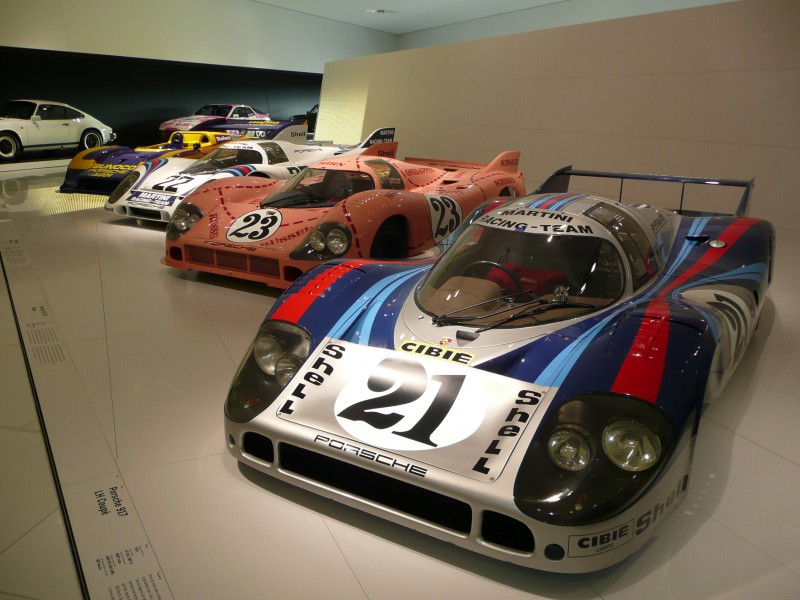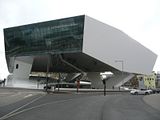
For many years, Porsche has had a small museum, tucked away down a side street adjoining the huge factory area in Zuffenhausen. Although there were a couple of discrete signs, you really had to know that it was there if you wanted to find it and pay a visit. No such bashfulness applies to the brand new museum, which opened to the public just one day before I was able to pay my visit. A bold, and very striking building, comprised of a huge steel structure, resting on just three concrete cores.Impressive as the building is, it is, of course, the contents which will draw the visitors. Approximately 80 vehicles are on show, in a very spacious display area on two floors, covering 53,800 square feet. It was quite busy during my visit, but I guess that is simply down to the fact that it was only the second day that the museum had been open, and lots of people wanted to see what was inside.
Before there were Porsche cars:
Ferdinand Porsche, a gifted engineer, developed an early interest in fire trucks. After he joined the Austro-Daimler organisation, he focused on such vehicles, and this one was the first time that personnel transport, a water pumper and a hose were all combined in the same vehicle. This particular 1912 fire engine served for 20 years at the plant, before it was transferred to an Austrian community who used it for a further 36 years.
 This Austro-Daimler “Sascha”, dating from 1922, could be seen as Ferdinand Porsche’s first vehicle designed for motor sport. The “Sascha” came first and second in the 1922 Targa Florio, at its first attempt, and went on to secure 43 separate victories. Key to its success was the vehicle’s light weight and optimised power to weight ratio.
This Austro-Daimler “Sascha”, dating from 1922, could be seen as Ferdinand Porsche’s first vehicle designed for motor sport. The “Sascha” came first and second in the 1922 Targa Florio, at its first attempt, and went on to secure 43 separate victories. Key to its success was the vehicle’s light weight and optimised power to weight ratio. In 1923, Porsche moved to Mercedes-Benz, and his first task as chief design engineer was to produce this 2-litre compressor-powered sports racing car. He tried some new technologies, using bronze to cast the cylinder heads, for better heat dissipation. Although ready to race at Monza in 1923, the race was postponed for 6 weeks, by which time the engine had been converted to a steel cylinder head, but the car still had technical problems. It was withdrawn from the race, but did see success in sprint and hillclimbs.
In 1923, Porsche moved to Mercedes-Benz, and his first task as chief design engineer was to produce this 2-litre compressor-powered sports racing car. He tried some new technologies, using bronze to cast the cylinder heads, for better heat dissipation. Although ready to race at Monza in 1923, the race was postponed for 6 weeks, by which time the engine had been converted to a steel cylinder head, but the car still had technical problems. It was withdrawn from the race, but did see success in sprint and hillclimbs. The Volkswagen hardly needs any introduction. Ferdinand Porsche presented his plans for a “people’s car” in January 1934. With its air-cooled rear engine, torsion bar suspension and an outer structure comprised of a body shell and base plate, this streamlined design for 4 occupants gave rise to the now very familiar “Beetle” silhouette. After the Second World War, production ramped up quickly, and by 1950 – the date of this vehicle – over 100,000 of these cars had been made.
The Volkswagen hardly needs any introduction. Ferdinand Porsche presented his plans for a “people’s car” in January 1934. With its air-cooled rear engine, torsion bar suspension and an outer structure comprised of a body shell and base plate, this streamlined design for 4 occupants gave rise to the now very familiar “Beetle” silhouette. After the Second World War, production ramped up quickly, and by 1950 – the date of this vehicle – over 100,000 of these cars had been made.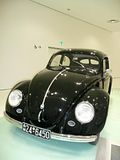 This Type 360 Cisitalia dates from 1947. Porsche Engineering were hired by Piero Dusio who wanted to launch his new brand, and the resulting car was technically far in advance of anything else on offer at the time. However, it never made it beyond testing, thanks to financial difficulties at Gmund.
This Type 360 Cisitalia dates from 1947. Porsche Engineering were hired by Piero Dusio who wanted to launch his new brand, and the resulting car was technically far in advance of anything else on offer at the time. However, it never made it beyond testing, thanks to financial difficulties at Gmund.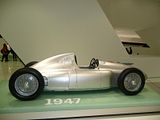 This is the first vehicle that you see as you near the top of the escalator, a Type 64, dating from 1939. Originally designed for the Berlin – Rome long distance race, this streamlined aluminium car is the basis for what became the 356, the first Porsche. Ferdinand Porsche used this car – fitted with a 1131cc engine, and capable of 130 km/h, thanks to its light body – for his own private use.
This is the first vehicle that you see as you near the top of the escalator, a Type 64, dating from 1939. Originally designed for the Berlin – Rome long distance race, this streamlined aluminium car is the basis for what became the 356, the first Porsche. Ferdinand Porsche used this car – fitted with a 1131cc engine, and capable of 130 km/h, thanks to its light body – for his own private use.
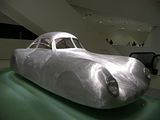 The birth of Porsche The first car to bear the name “Porsche” was this, the “Number 1” Roadster, dating from 1948. The car was ready to roll on June 8th and the local Carinthian government issued a permit to allow it to be tested on public roads. Fitted with a VW engine, boosted to 35 bhp, because it weighed only 585kg, it could achieve 135 km/h.
The birth of Porsche The first car to bear the name “Porsche” was this, the “Number 1” Roadster, dating from 1948. The car was ready to roll on June 8th and the local Carinthian government issued a permit to allow it to be tested on public roads. Fitted with a VW engine, boosted to 35 bhp, because it weighed only 585kg, it could achieve 135 km/h. Also dating from 1948, this 356/2 Coupe was a development of the 356 “Number 1” Roadster. A small series of these cars – 52 in total – were assemble by hand in the Austrian town of Gmund. Based on the Volkswagen, to create space for two small rear seats and a small luggage area, the 1086cc engine was mounted behind the rear axle. With a low drag coefficient, these cars became the basis for Porsche’s entry to motorsports.
Also dating from 1948, this 356/2 Coupe was a development of the 356 “Number 1” Roadster. A small series of these cars – 52 in total – were assemble by hand in the Austrian town of Gmund. Based on the Volkswagen, to create space for two small rear seats and a small luggage area, the 1086cc engine was mounted behind the rear axle. With a low drag coefficient, these cars became the basis for Porsche’s entry to motorsports.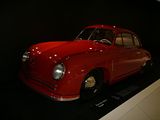
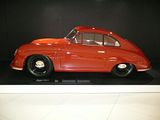
The first Type 356 came off the Stuttgart production line on Maunday Thursday in 1950. The car was given the nickname “Ferdinand”, and was presented to Ferdinand Porsche on his 75th birthday later that year.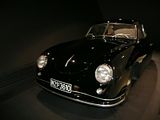
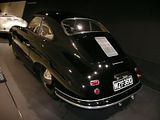 This 356 America Roadster, dating from 1953 was built exclusively for the North American market. Much lighter than the standard cars, thanks not just to its lightweight aluminium body, but weight saving doors and rain top, a spartan interior, it was intended primarily for racing.
This 356 America Roadster, dating from 1953 was built exclusively for the North American market. Much lighter than the standard cars, thanks not just to its lightweight aluminium body, but weight saving doors and rain top, a spartan interior, it was intended primarily for racing.
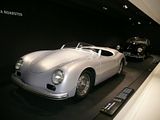 A 1954 Type 356 1500 Coupe, providing evidence of the continuing development of the basic design.
A 1954 Type 356 1500 Coupe, providing evidence of the continuing development of the basic design.
 The 10,000th Porsche car, a 356A, was delivered in 1956. Further changes can be seen, including a deeper curved windscreen. By now, the car was a 1582cc engine, good for 175 km/h.
The 10,000th Porsche car, a 356A, was delivered in 1956. Further changes can be seen, including a deeper curved windscreen. By now, the car was a 1582cc engine, good for 175 km/h.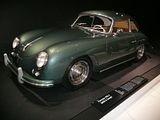
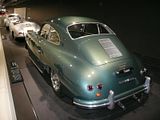 The 356 1500 Speedster was a made to order export model. The US importer wanted a car at less than US$3000, so paring down some of the features was the way to achieve this. The car was well received, and quickly made its mark in motor sport.
The 356 1500 Speedster was a made to order export model. The US importer wanted a car at less than US$3000, so paring down some of the features was the way to achieve this. The car was well received, and quickly made its mark in motor sport.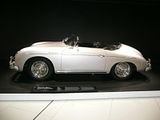
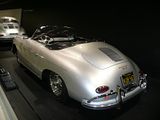 This 356B 2000 GS Carrera GT from 1960 was much re-engineered, with new technology, including a safety steering system, hydraulic shock absorbers and far better cooling of the brakes.
This 356B 2000 GS Carrera GT from 1960 was much re-engineered, with new technology, including a safety steering system, hydraulic shock absorbers and far better cooling of the brakes.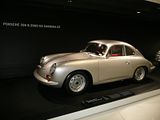
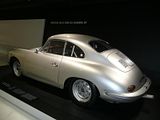 This 1962 356B Carrera 2 Cabriolet could hit 100 km/h in 9.4 seconds, a time which usually required an engine at least twice the size of the 2 litre engine fitted to this car. Only 34 of this particular model were built.
This 1962 356B Carrera 2 Cabriolet could hit 100 km/h in 9.4 seconds, a time which usually required an engine at least twice the size of the 2 litre engine fitted to this car. Only 34 of this particular model were built.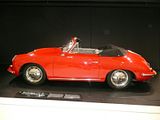
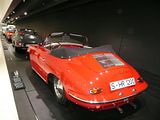
The 356 became a popular police car across many European countries. The very last 10 of the 356C 1600 SC Cabriolets ever made were delivered to the Netherlands police.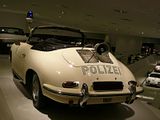
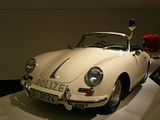 The 911 Story Precursor to the famous 911 is this, the Type 754, dating from 1959. A full four seater, that turned out to be one of the reasons why this car never actually went into production, as Ferry Porsche was dead against the idea of 4 seats. Eventually, he did accept a revised version with two “marginal” rear seats.
The 911 Story Precursor to the famous 911 is this, the Type 754, dating from 1959. A full four seater, that turned out to be one of the reasons why this car never actually went into production, as Ferry Porsche was dead against the idea of 4 seats. Eventually, he did accept a revised version with two “marginal” rear seats.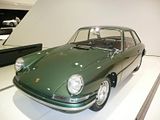
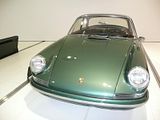
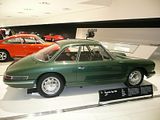
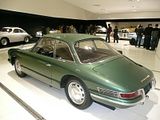

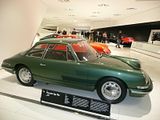 The production car was launched at Frankfurt in 1963, and was christened 901. As is now well known, Peugeot objected, as they had registered all three digit numbers with a zero in the middle, and so the car was renamed the 911. Most immediate difference from its predecessor was the use of a 6 cylinder engine.
The production car was launched at Frankfurt in 1963, and was christened 901. As is now well known, Peugeot objected, as they had registered all three digit numbers with a zero in the middle, and so the car was renamed the 911. Most immediate difference from its predecessor was the use of a 6 cylinder engine.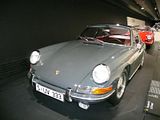
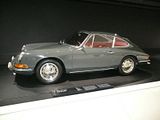
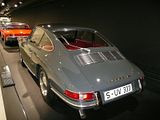 The first 911 Targa appeared in the 1960s, a hybrid design part way between a convertible and a coupe.
The first 911 Targa appeared in the 1960s, a hybrid design part way between a convertible and a coupe.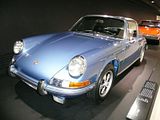
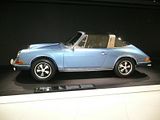
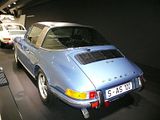 Development continued during the 1960s (and beyond). This 1970 prototype, called the 915, had an extra 350mm in the wheelbase, in an attempt to make the 911 a true four seater. Although the project lingered for several years, it never saw production.
Development continued during the 1960s (and beyond). This 1970 prototype, called the 915, had an extra 350mm in the wheelbase, in an attempt to make the 911 a true four seater. Although the project lingered for several years, it never saw production.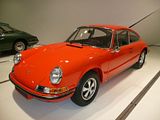
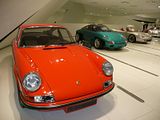
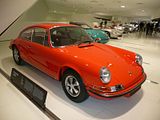
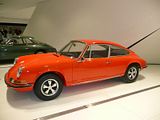
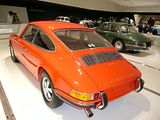 Now 35 years old, but still revered as one of the very best 911s ever, the 1973 911 RS Carrera.. This 2.7 litre car was the first 911 ever called “Carrera”, a reference to the Carrera Panamerica road race.
Now 35 years old, but still revered as one of the very best 911s ever, the 1973 911 RS Carrera.. This 2.7 litre car was the first 911 ever called “Carrera”, a reference to the Carrera Panamerica road race.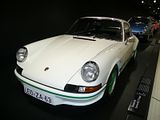
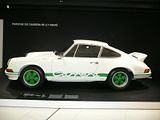 Launched in the aftermath of the 1973 Fuel Crisis, the 911 Turbo quickly became an icon, and was seen by many as a more practical alternative to the Ferrari and Lamborghini supercars of the day.
Launched in the aftermath of the 1973 Fuel Crisis, the 911 Turbo quickly became an icon, and was seen by many as a more practical alternative to the Ferrari and Lamborghini supercars of the day.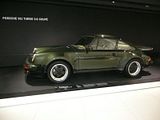 This 911 Carrera Coupe dates from 1988. This bodystyle ran from 1974 for just over 15 years, and to many is still the “classic” 911 style.
This 911 Carrera Coupe dates from 1988. This bodystyle ran from 1974 for just over 15 years, and to many is still the “classic” 911 style.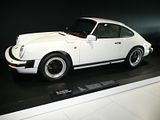
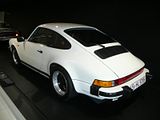 The first true convertible 911 was launched in 1993, and it quickly became far more popular than the Targa model that it supplanted.
The first true convertible 911 was launched in 1993, and it quickly became far more popular than the Targa model that it supplanted.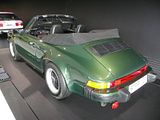 At the 1987 Frankfurt Show, Porsche presented a 911 Speedster. Low lung, with a shortened windscreen and manual rain top that disappears under a steel cover, this car was not that well received in Europe at the time. Now these cars are highly prized and highly prized.
At the 1987 Frankfurt Show, Porsche presented a 911 Speedster. Low lung, with a shortened windscreen and manual rain top that disappears under a steel cover, this car was not that well received in Europe at the time. Now these cars are highly prized and highly prized.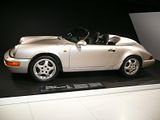 This “993” model 911 was built on July 15th 1996, and it was the one millionth Porsche car ever built. It was presented to the German State of Baden-Wurttenberg and saw active service with the German Police.
This “993” model 911 was built on July 15th 1996, and it was the one millionth Porsche car ever built. It was presented to the German State of Baden-Wurttenberg and saw active service with the German Police.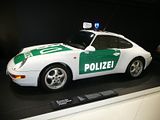
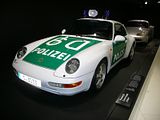 On the top floor of the museum you can find a series of 5 generations of the 911 Turbo: The original from 1975, sometimes called the 930, which delivered a heady 260 bhp. At the time, an astonishing figure for a 3.0 engine.
On the top floor of the museum you can find a series of 5 generations of the 911 Turbo: The original from 1975, sometimes called the 930, which delivered a heady 260 bhp. At the time, an astonishing figure for a 3.0 engine.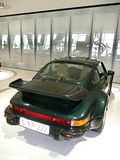
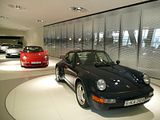
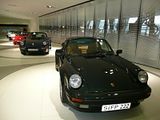
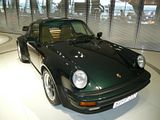
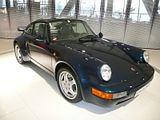
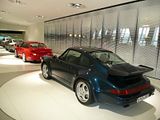

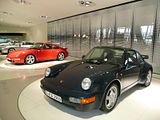 The “964” model , dating from 1990. By now, 320 bhp was achieved from the 3.3 litre engine.
The “964” model , dating from 1990. By now, 320 bhp was achieved from the 3.3 litre engine.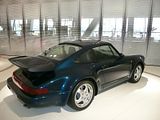 This “993” model seemed to be attracting more attention than any of the other Turbo models….. still stunning looking, and with power up to 408 bhp from its bi-turbo engine, all wheel drive, and six gears.
This “993” model seemed to be attracting more attention than any of the other Turbo models….. still stunning looking, and with power up to 408 bhp from its bi-turbo engine, all wheel drive, and six gears.

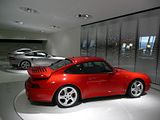
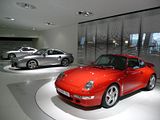 The next generation was the “996” model, with 450 bhp from the same-sized 3.6 litre engine, now water-cooled.
The next generation was the “996” model, with 450 bhp from the same-sized 3.6 litre engine, now water-cooled.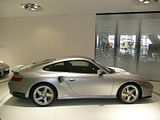
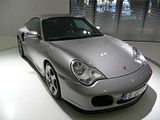 A modern “997”, loaded with all the latest technology from the 21st Century.
A modern “997”, loaded with all the latest technology from the 21st Century. Badged as a 911, but only loosely related, as it was really built as the compliance required to enable the 911 GT1 to go racing. These street legal cars were based on the front end of a 996, and the small number made each sold for DM1.5 million.
Badged as a 911, but only loosely related, as it was really built as the compliance required to enable the 911 GT1 to go racing. These street legal cars were based on the front end of a 996, and the small number made each sold for DM1.5 million.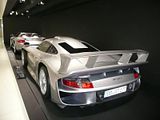
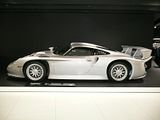 Beyond the 911 The long-standing relationship with Volkswagen meant that the 2 companies worked jointly on a new mid-engined sports cars in the late 60s. Launched as the 914, two cars were offered: a 4 cylinder model, for VW, the 914/4 and a six cylinder one for Porsche, the 914/6. Hard to believe now, but this car sold like the proverbial hot cakes, with over 120,00 cars sold in a six year period.
Beyond the 911 The long-standing relationship with Volkswagen meant that the 2 companies worked jointly on a new mid-engined sports cars in the late 60s. Launched as the 914, two cars were offered: a 4 cylinder model, for VW, the 914/4 and a six cylinder one for Porsche, the 914/6. Hard to believe now, but this car sold like the proverbial hot cakes, with over 120,00 cars sold in a six year period.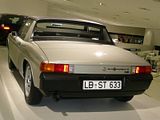
 Two cars were built with an 8 cylinder engine, the 914/8, and this one was presented to Ferry Porsche on his 60th birthday.
Two cars were built with an 8 cylinder engine, the 914/8, and this one was presented to Ferry Porsche on his 60th birthday.
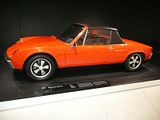
 During the mid 70s, Porsche decided to build another lower-priced vehicle. The result was the 924, first shown at the every end of 1975. This particular model, called “Baustufe 1” is an early prototype from 1974 and is not quite the same as the model that finally appeared on the market and which did so much to satisfy the demand from “Yuppies” in the 1980s for their first Porsche.
During the mid 70s, Porsche decided to build another lower-priced vehicle. The result was the 924, first shown at the every end of 1975. This particular model, called “Baustufe 1” is an early prototype from 1974 and is not quite the same as the model that finally appeared on the market and which did so much to satisfy the demand from “Yuppies” in the 1980s for their first Porsche.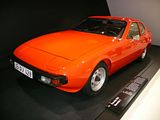
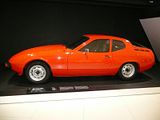
 Just like all previous models, the 924 model evolved considerably over time. This 924 Carerra GTS was intended for racing, at which it was particularly successful.
Just like all previous models, the 924 model evolved considerably over time. This 924 Carerra GTS was intended for racing, at which it was particularly successful.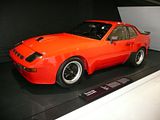
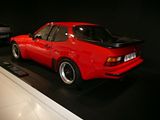 Later models, with a Porsche-designed engined were the 944, and finally the 968. In time, a convertible model was launched, and this is one of the last models made, in 1995. With its demise came the end of the 4 cylinder Porsche.
Later models, with a Porsche-designed engined were the 944, and finally the 968. In time, a convertible model was launched, and this is one of the last models made, in 1995. With its demise came the end of the 4 cylinder Porsche.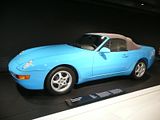
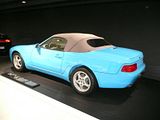 Intended to replace the 911, the 928 ended up having a much shorter life, and being positioned as more of a luxury tourer. Not that well regarded when first launched, it has many more fans now. The 928 does have the distinction of being the only car of its type ever to win the “Car of the Year” award.
Intended to replace the 911, the 928 ended up having a much shorter life, and being positioned as more of a luxury tourer. Not that well regarded when first launched, it has many more fans now. The 928 does have the distinction of being the only car of its type ever to win the “Car of the Year” award.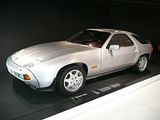
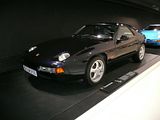
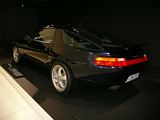 Designed to meet the Group B regulations in the early 1980s, the 959 was a technological tour de force. 292 of these cars were made, and they were highly priced and highly prized when new. Despite the cost, they quickly sold out.
Designed to meet the Group B regulations in the early 1980s, the 959 was a technological tour de force. 292 of these cars were made, and they were highly priced and highly prized when new. Despite the cost, they quickly sold out.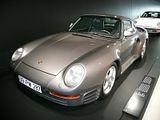
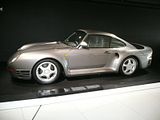
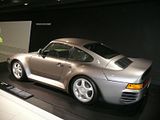 Hard to believe now, but Porsche was in deep trouble as a consequence of the last recession. So much so that it was touch and go whether they could survive. The rescue came with the launch of the Boxster in 1996.
Hard to believe now, but Porsche was in deep trouble as a consequence of the last recession. So much so that it was touch and go whether they could survive. The rescue came with the launch of the Boxster in 1996.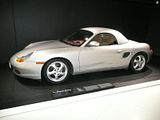 The ultimate Porsche has to be this, the Carrera GT. Just awesome!
The ultimate Porsche has to be this, the Carrera GT. Just awesome!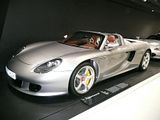

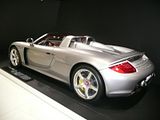 Porsche in Motor Sport Ferdinand Porsche had been passionate about Motor Sport long before the founding of the car that bears his name. It only took a few months after the first 356 Number 1 roadster prototype was supplanted with this, the 356 SL couple, dating from 1950. The 46 PS engine, clothed in a light and aerodynamic body propelled this car to 160 km/h.
Porsche in Motor Sport Ferdinand Porsche had been passionate about Motor Sport long before the founding of the car that bears his name. It only took a few months after the first 356 Number 1 roadster prototype was supplanted with this, the 356 SL couple, dating from 1950. The 46 PS engine, clothed in a light and aerodynamic body propelled this car to 160 km/h. The first Porsche ever built specifically for racing was the 550 Spyder, which was premiered in 1954.
The first Porsche ever built specifically for racing was the 550 Spyder, which was premiered in 1954.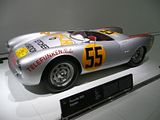
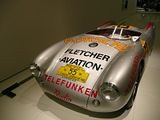 This 550 A Spyder, from 1956, gained fame for a different reason. In 1955, James Dean was killed while driving his, en route to the Salinas, CA, race track, when he was hit by another driver.
This 550 A Spyder, from 1956, gained fame for a different reason. In 1955, James Dean was killed while driving his, en route to the Salinas, CA, race track, when he was hit by another driver.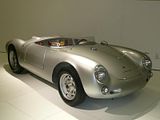 In 1960, a small production series of 21 cars, based on the 356 series, were completed by Abarth. The bodies of these aluminium cars were designed by Scaglione, and the car enjoyed much success in GT racing.
In 1960, a small production series of 21 cars, based on the 356 series, were completed by Abarth. The bodies of these aluminium cars were designed by Scaglione, and the car enjoyed much success in GT racing.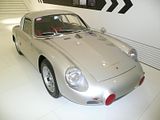
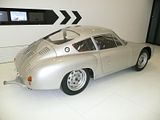 The 718 W-RS Spyder, Porsche’s first 2 liter 8 cylinder car was affectionately nicknamed “Grandmother” because of its unusually long, and successful motor sport career, which lasted from 1961 to 1964.
The 718 W-RS Spyder, Porsche’s first 2 liter 8 cylinder car was affectionately nicknamed “Grandmother” because of its unusually long, and successful motor sport career, which lasted from 1961 to 1964.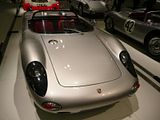 The 904 GTS, revealed in 1964, was the first Porsche with a plastic body. Just five months after launch, the car won the Targa Florio, and also succeeded at Le Mans and the Monte Carlo Rally. It remains one of the most beautiful racing cars ever made.
The 904 GTS, revealed in 1964, was the first Porsche with a plastic body. Just five months after launch, the car won the Targa Florio, and also succeeded at Le Mans and the Monte Carlo Rally. It remains one of the most beautiful racing cars ever made.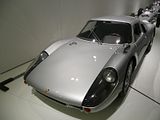
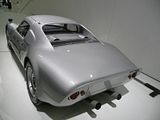 Probably the most famous Porsche racing cars ever were the 917 series. With the odds stacked against them, Hans Hermann and Richard Attwood managed to take this KH Coupe version to victory at Le Mans in 1970.
Probably the most famous Porsche racing cars ever were the 917 series. With the odds stacked against them, Hans Hermann and Richard Attwood managed to take this KH Coupe version to victory at Le Mans in 1970.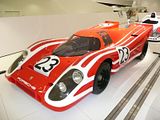 One of the most impressive sights (and there are plenty here) is this line up of 917 cars. This 917 PA Spyder, from 1969, was developed to compete for the American CanAm Series, and was fitted with a 16 cylinder engine. However, it never made it beyond the test track,as the 12 cylinder proved far stronger.
One of the most impressive sights (and there are plenty here) is this line up of 917 cars. This 917 PA Spyder, from 1969, was developed to compete for the American CanAm Series, and was fitted with a 16 cylinder engine. However, it never made it beyond the test track,as the 12 cylinder proved far stronger.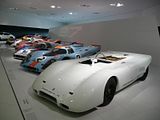 The Gulf Oil livery of this 917 KH Coupe from 1970 is distinctive. In the 1000km race at Spa in 1971, the car averaged 249 km/h, a record that still stands.
The Gulf Oil livery of this 917 KH Coupe from 1970 is distinctive. In the 1000km race at Spa in 1971, the car averaged 249 km/h, a record that still stands.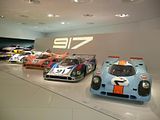 This is a long tailed version of the 917, the LH, built specifically for Le Mans, where it hit 387 km/h on the Mulsanne straight, in 1971. Despite this, in three attempts, the car failed to secure victory.
This is a long tailed version of the 917, the LH, built specifically for Le Mans, where it hit 387 km/h on the Mulsanne straight, in 1971. Despite this, in three attempts, the car failed to secure victory.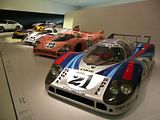 A hybrid of the short and long tailed versions, this 917/20 is the only such car built. The unusual colour scheme earned the car the nickname “Pink Pig”. Sadly, it failed to finish at Le Mans.
A hybrid of the short and long tailed versions, this 917/20 is the only such car built. The unusual colour scheme earned the car the nickname “Pink Pig”. Sadly, it failed to finish at Le Mans.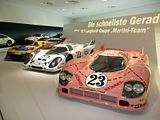 Dating from 1973, this 917/30 dominated the circuit races in which it competed. The Americans were so fed up that they subsequently changed the racing regulations, to exclude the 917 altogether.
Dating from 1973, this 917/30 dominated the circuit races in which it competed. The Americans were so fed up that they subsequently changed the racing regulations, to exclude the 917 altogether. Developed specifically for the World Sports Car championship was this, the 936. The first turbo car to win at Le Mans in 1976, and the car scored another win the following year. Sensationally, it returned in 1981 and won again.
Developed specifically for the World Sports Car championship was this, the 936. The first turbo car to win at Le Mans in 1976, and the car scored another win the following year. Sensationally, it returned in 1981 and won again.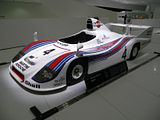 Also dating from 1981 was this, the 924 GTP Le Mans, which turned out to be a precursor for the road-going 944.
Also dating from 1981 was this, the 924 GTP Le Mans, which turned out to be a precursor for the road-going 944. Once the roadgoing 944 was announced, it was not long before Porsche came up with a Manufacturer Cup for the 944 Turbo cars such as this one.
Once the roadgoing 944 was announced, it was not long before Porsche came up with a Manufacturer Cup for the 944 Turbo cars such as this one.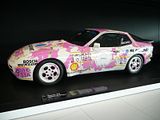 The only all wheel drive Porsche to start at le Mans is this, the 961, dating from 1986.
The only all wheel drive Porsche to start at le Mans is this, the 961, dating from 1986. 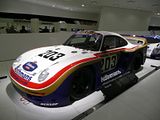 Between 1982 and 1994, Porsche sports cars of the 956/962 type won Le Mans no less than 7 times, and they dominated on many other tracks as.well. The 962C shown here is based on a 956, with a 120mm longer wheelbase. This particular car is the 1987 winner.
Between 1982 and 1994, Porsche sports cars of the 956/962 type won Le Mans no less than 7 times, and they dominated on many other tracks as.well. The 962C shown here is based on a 956, with a 120mm longer wheelbase. This particular car is the 1987 winner.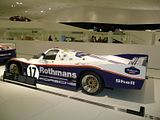 In 1998, Porsche celebrated their 50th anniversary with a double victory at Le Mans with this, the 911 GT1.
In 1998, Porsche celebrated their 50th anniversary with a double victory at Le Mans with this, the 911 GT1.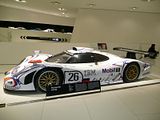 Most recently, there came the RS Spyder. In the three years since it was launched, it has won all four championship titles in driver, team, chassis and engine rankings in the American Le Mans Series.
Most recently, there came the RS Spyder. In the three years since it was launched, it has won all four championship titles in driver, team, chassis and engine rankings in the American Le Mans Series.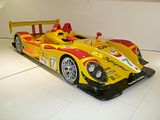 Other Prototypes and Concept Cars The Panamericana was completed in 1989, as a birthday present for Ferry Porsche on the occasion of his 80th birthday. It was also shown at the Frankfurt IAA show that year. Although this car did not go into production, the roof mechanism was further developed and then put into production for the 911 Targa.
Other Prototypes and Concept Cars The Panamericana was completed in 1989, as a birthday present for Ferry Porsche on the occasion of his 80th birthday. It was also shown at the Frankfurt IAA show that year. Although this car did not go into production, the roof mechanism was further developed and then put into production for the 911 Targa. The Boxster Design Study was presented at the 1993 Detroit Show and was so well received, combining elements of the traditional 356 Speedster and 550, that Porsche decided to put the car into production.
The Boxster Design Study was presented at the 1993 Detroit Show and was so well received, combining elements of the traditional 356 Speedster and 550, that Porsche decided to put the car into production.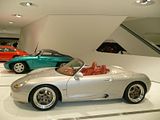

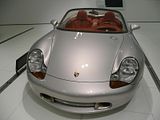 Built in 1987, this 928 Studie H50 was made for Ferry Porsche. What a shame that it remains a one-off……… I think it looks fantastic.
Built in 1987, this 928 Studie H50 was made for Ferry Porsche. What a shame that it remains a one-off……… I think it looks fantastic.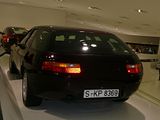
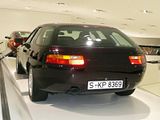
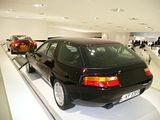 Even more intriguing is this, the C88, built in 1994 by Porsche Engineering as a possible low-cost vehicle for the Chinese market. Definite shades of the Dacia Logan, but from 10 years earlier. In the end the government did not give Porsche the necessary licence to go ahead. Perhaps no bad thing!
Even more intriguing is this, the C88, built in 1994 by Porsche Engineering as a possible low-cost vehicle for the Chinese market. Definite shades of the Dacia Logan, but from 10 years earlier. In the end the government did not give Porsche the necessary licence to go ahead. Perhaps no bad thing!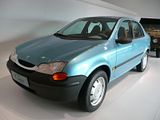
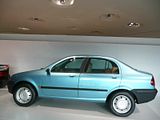
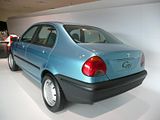 Rather earlier – dating from 1956 – is this, the Type 597 “Jagdwagn”. An amphibious vehicle built in response to a request for bids from the German Bundeswehr. When presented, it was used to recover some of its competitors that got stuck in the mud.
Rather earlier – dating from 1956 – is this, the Type 597 “Jagdwagn”. An amphibious vehicle built in response to a request for bids from the German Bundeswehr. When presented, it was used to recover some of its competitors that got stuck in the mud.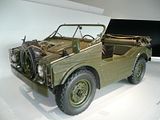 Current Cars A small display of current models is also presented:
Current Cars A small display of current models is also presented: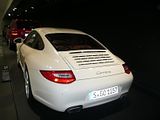
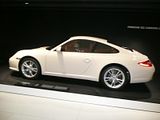

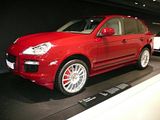
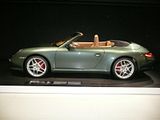
And finally……….. By 1963, Porsche had sold an incredible 120,000 of these distinctive tractors. This one dates from 1959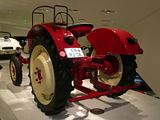
 I really do commend this museum to anyone who’s in the area. It is very easy to find, just a couple of kms from the autobahn network, and with its own station right by the museum. There’s also a huge Porsche showroom next door, which is also worth a look. Oh, and the other side of Stuttgart, of course, houses the marvellous Mercedes Museum as well.
I really do commend this museum to anyone who’s in the area. It is very easy to find, just a couple of kms from the autobahn network, and with its own station right by the museum. There’s also a huge Porsche showroom next door, which is also worth a look. Oh, and the other side of Stuttgart, of course, houses the marvellous Mercedes Museum as well.2009-12-04 15:49:52






































































































































